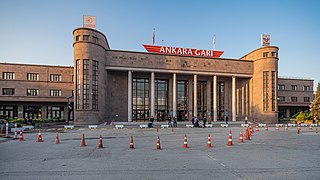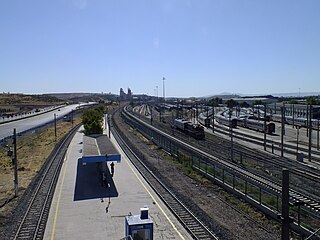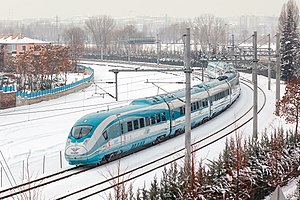The Hinton train collision was a rail transport accident that occurred in Canada on 8 February 1986. Twenty-three people were killed in a collision between a Canadian National Railway freight train and a Via Rail passenger train called the Super Continental, including the engine crews of both trains. It was the deadliest rail disaster in Canada since the Dugald accident of 1947, which had thirty-one fatalities, and was not surpassed until the Lac-Mégantic rail disaster in 2013, which resulted in 47 deaths.

The Turkish State Railways (TCDD) started building high-speed rail lines in 2003. TCDD has branded its high-speed service as Yüksek Hızlı Tren (YHT) which currently operates on two lines: the Ankara–Istanbul high-speed railway and the Ankara–Konya high-speed railway. YHT is the only high-speed rail service in Turkey, with two types of EMU train models operating at speeds of up to 250 km/h (HT65000) or 300 km/h (HT80000).
A runaway train is a type of railroad incident in which unattended rolling stock is accidentally allowed to roll onto the main line, a moving train loses enough braking power to be unable to stop in safety, or a train operates at unsafe speeds due to loss of operator control. If the uncontrolled rolling stock derails or hits another train, it will result in a train wreck.

Ankara railway station is the main railway station in Ankara, Turkey, and is a major transportation hub within the city. The station is the eastern terminus of the Istanbul-Ankara railway corridor, as well as the easternmost station in Turkey with high-speed rail service. Ankara station is also a hub for YHT high-speed trains, with its own exclusive platforms and concourse. TCDD Taşımacılık also operates intercity train service to Kars, Tatvan and Kurtalan as well as Başkentray commuter rail service.

The Ankara–Istanbul high-speed railway, is a 562 km (349 mi) long high-speed railway linking Ankara and Istanbul in Turkey. The railway runs mostly parallel to the Istanbul-Ankara railway and passes through some of Turkey's most urbanized areas. The line hosts high-speed YHT train service with a maximum operating speed of 250 km/h (160 mph).

The State Railways of the Republic of Turkey, abbreviated as TCDD, is a government-owned national railway company responsible with the ownership and maintenance of railway infrastructure in Turkey, as well as the planning and construction of new lines. TCDD was formed on 4 June 1929 as part of the nationalisation of railways in Turkey.

The Çamlık Railway Museum, a.k.a. Çamlık Steam Locomotive Museum, is an outdoor railway museum at Çamlık village of Selçuk district in Izmir Province, Turkey. It is the largest railway museum in Turkey and contains one of the largest steam locomotive collections in Europe.
The Pamukova train derailment was a fatal railway accident which occurred in 2004 at Pamukova district of Sakarya Province in northwestern Turkey when a higher speed train derailed, at which 41 passengers were killed and 80 injured.
The Yarımburgaz train disaster was a head-on collision of two trains that occurred near Yarımburgaz, Küçükçekmece, west of Istanbul in Turkey on 20 October 1957. With 95 dead and 150 wounded people, it is the worst train accident so far in the country.

TCDD HT80000 is a series of high-speed electric multiple units built by Siemens for the Turkish State Railways. The EMUs are used for the Yüksek Hızlı Tren (YHT) services on the Turkish high-speed railway network and especially on the Polatlı–Konya high-speed railway, where they can reach a maximum speed of 300 km/h.

TCDD Taşımacılık A.Ş. is a government-owned railway company responsible for the operations of most passenger and freight rail in Turkey. The company was formed on 14 June 2016, splitting off from the Turkish State Railways (TCDD) to take over railway operations, while TCDD would continue to administer railway infrastructure. TCDD Taşımacılık officially began operations on 1 January 2017.

Marşandiz railway station is a railway station on the Başkentray commuter rail line in Ankara, Turkey. It is located adjacent to Marşandiz Yard and services mainly railway employees who work there. In July 2016, the station was closed down ad subsequently demolished and rebuilt as part of the Başkentray rehabilitation project. The new station site was moved about 200 m (660 ft) east and opened on 12 April 2018. Marşandiz station also replaced Motor Fabrikası station, which closed down in 2016, hence the relocation to the east. Before 2016, the station had one exit to Anadolu Boulevard, which crossed the tracks on a north-south axis. The new station will no longer have access to the Boulevard and will instead have exits to Güvercinlik Avenue and Güvercin Road.
The Çorlu train derailment was a fatal railway accident which occurred in 2018 at the Çorlu district of Tekirdağ Province in northwestern Turkey when a train derailed, killing 24 passengers and injuring 318, including 42 severely.
The Kütahya train derailment was a fatal railway accident, which occurred in 2008 near Çöğürler village of Kütahya in western Turkey, when an express train derailed, killing 9 and injuring 30 passengers.










